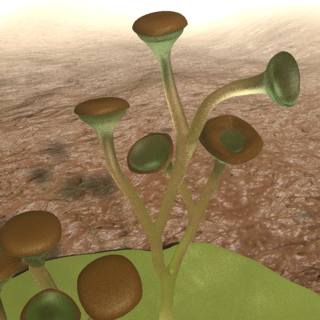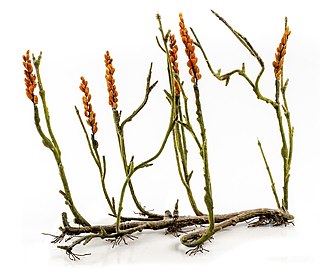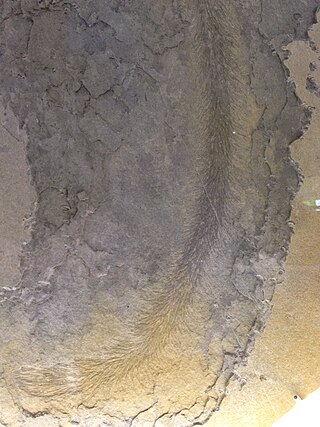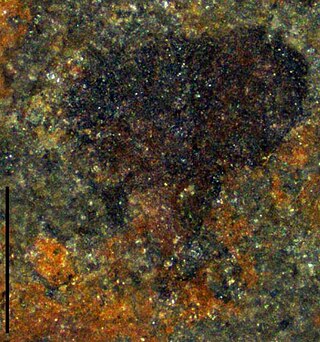
Cooksonia is an extinct group of primitive land plants, treated as a genus, although probably not monophyletic. The earliest Cooksonia date from the middle of the Silurian ; the group continued to be an important component of the flora until the end of the Early Devonian, a total time span of 433 to 393 million years ago. While Cooksonia fossils are distributed globally, most type specimens come from Britain, where they were first discovered in 1937. Cooksonia includes the oldest known plant to have a stem with vascular tissue and is thus a transitional form between the primitive non-vascular bryophytes and the vascular plants.

The zosterophylls are a group of extinct land plants that first appeared in the Silurian period. The taxon was first established by Banks in 1968 as the subdivision Zosterophyllophytina; they have since also been treated as the division Zosterophyllophyta or Zosterophyta and the class or plesion Zosterophyllopsida or Zosteropsida. They were among the first vascular plants in the fossil record, and had a world-wide distribution. They were probably stem-group lycophytes, forming a sister group to the ancestors of the living lycophytes. By the late Silurian a diverse assemblage of species existed, examples of which have been found fossilised in what is now Bathurst Island in Arctic Canada.

Baragwanathia is a genus of extinct lycopsid plants of Late Silurian to Early Devonian age, fossils of which have been found in Australia, Canada, China and Czechia. The name derives from William Baragwanath who discovered the first specimens of the type species, Baragwanathia longifolia, at Thomson River.

Tortilicaulis is a moss-like plant known from fossils recovered from southern Britain, spanning the Silurian-Devonian boundary. Originally recovered from the Downtonian of the Welsh borderlands, Tortilicaulis has since been recovered in the famous Ludlow Lane locality.

Psilophyton is a genus of extinct vascular plants. Described in 1859, it was one of the first fossil plants to be found which was of Devonian age. Specimens have been found in northern Maine, USA; Gaspé Bay, Quebec and New Brunswick, Canada; the Czech Republic; and Yunnan, China. Plants lacked leaves or true roots; spore-forming organs or sporangia were borne on the ends of branched clusters. It is significantly more complex than some other plants of comparable age and is thought to be part of the group from within which the modern ferns and seed plants evolved.
Ornatifilum is an artificial form genus, which is used to categorise any small, branched filaments with external ornamentation.

Polysporangiophytes, also called polysporangiates or formally Polysporangiophyta, are plants in which the spore-bearing generation (sporophyte) has branching stems (axes) that bear sporangia. The name literally means 'many sporangia plant'. The clade includes all land plants (embryophytes) except for the bryophytes whose sporophytes are normally unbranched, even if a few exceptional cases occur. While the definition is independent of the presence of vascular tissue, all living polysporangiophytes also have vascular tissue, i.e., are vascular plants or tracheophytes. Extinct polysporangiophytes are known that have no vascular tissue and so are not tracheophytes.

Aglaophyton major was the sporophyte generation of a diplohaplontic, pre-vascular, axial, free-sporing land plant of the Lower Devonian. It had anatomical features intermediate between those of the bryophytes and vascular plants or tracheophytes.
Sawdonia is an extinct genus of early vascular plants, known from the Upper Silurian to the Lower Carboniferous. Sawdonia is best recognized by the large number of spikes (enations) covering the plant. These are vascular plants that do not have vascular systems in their enations. The first species of this genus was described in 1859 by Sir J. William Dawson and, was originally attributed to the genus Psilophyton. He named this plant Psilophyton princeps. In 1971 Francis Hueber proposed a new genus for this species due to its "Divergent technical characters from the generic description for Psilophyton." The holotype used for description is Dawson Collection Number 48, pro parte, Museum Specimen Number 3243. Sir J. William Dawson Collection, Peter Redpath Museum, McGill University, Montreal, Quebec, Canada.
Distichophytum is a genus of extinct vascular plants of the Late Silurian (Ludfordian) to Early Devonian (Emsian), around 426 to 393 million years ago. The genus has a tangled taxonomic history, also being known as Bucheria and Rebuchia.
Junggaria was a genus of rhyniophyte-like land plants known from fossils found in China in Upper Silurian strata. It bore leafless dichotomously or pseudomonopodially branching axes, some of which ended in spore-forming organs or sporangia of complex shape. The genus Cooksonella, found in Kazakhstan from deposits of a similar age, is considered to be an illegitimate synonym.
Danziella is a genus of extinct vascular plants of the Early Devonian. Fossils found in the Artois region of northern France were first described as Zosterophyllum artesianum, but a later review by Edwards showed that they did not fit the circumscription of that genus.

Aberlemnia is a genus of extinct vascular plants of the Early Devonian, which consisted of leafless stems with terminal spore-forming organs (sporangia). Fossils found in Scotland were initially described as Cooksonia caledonica. A later review, which included new and more complete fossils from Brazil, showed that the specimens did not fit the circumscription of the genus Cooksonia; accordingly a new genus Aberlemnia was proposed.

Ventarura is a genus of extinct vascular plants of the Early Devonian. Fossils were found in the Windyfield chert, Rhynie, Scotland. Some features, such as bivalved sporangia borne laterally and the anatomy of the xylem, relate this genus to the zosterophylls. Other features are unclear due to poor preservation.
Lycopodolica is a genus of extinct plants of the Late Silurian. Fossils were found in the Rashkov Beds in Podolia in modern Ukraine. Plants there are preserved as compressions without internal detail. Lycopodolica had stems (axes) which appear to have branched and which are covered with lax, hair- or thread-like outgrowths. Considered to be a lycophyte, Lycopodolica differs from Baragwanathia in the nature of its outgrowths or enations. It was listed as a lycopsid by Hao and Xue in 2013.

Macivera is a genus of extinct vascular plants. Fossils were found in sediments in Bathust Island, Nunavut, Canada, from the upper Silurian. The leafless stems (axes) branched dichotomously and were relatively thin, being between 0.7 and 1.0 mm wide. Spore-forming organs or sporangia, which were elliptical, being longer than wide, were borne on the end regions of stems. Macivera is considered to be a zosterophyll.
Psilophytites is a form genus of extinct plants; it was created by Høeg for spiny stems (axes) which cannot be assigned to a more precise genus or species, usually because spore-forming organs or sporangia are not present.
Yarravia is a genus of extinct vascular plants mainly known from fossils found in Victoria, Australia. Originally the rocks in which they were found were considered to be late Silurian in age; more recently they have been found to be Early Devonian. Specimens consist only of incomplete leafless stems, some of which bore groups of spore-forming organs or sporangia which were fused, at least at the base.
Hollandophyton is a genus of extinct plants known from fossils found in Shropshire, England, in rocks of upper Silurian age. The specimens are fragmentary, consisting of leafless stems (axes) which branched dichotomously and bore kidney-shaped spore-forming organs or sporangia, apparently at their tips. The internal structure of the stems is unknown.

Taeniocrada is a genus of extinct plants of Devonian age. It is used as a form genus for fossil plants with leafless flattened stems which divided dichotomously and had prominent midribs regarded as containing vascular tissues. It has been suggested that some species assigned to this genus were aquatic.










